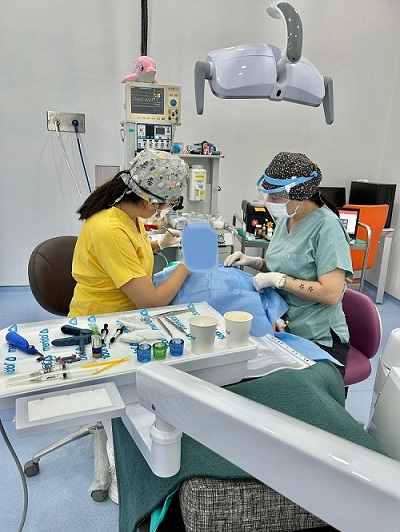Dental treatments can be performed under sedation for child patients who cannot have dental treatment in the chair, people who cannot overcome their fear of dentists, and disabled individuals.
sedation; It can be defined as a state of sleep in which the patient’s spontaneous breathing and all reflexes are preserved with medications, the level of consciousness is suppressed in a controlled manner, and the depth can be adjusted.
The procedure must be performed under operating room conditions in a hospital or center, accompanied by a pediatric dentist and an anesthesiologist.
On the day of the procedure, the child is taken to a special room with his family in the hospital, where there are little surprises.
In the presence of the parents, the child is first given a sedative medicine in the form of oral syrup to help the child relax. The child, who falls into a light sleep due to the effect of the medicine, is taken to the operating room. In this way, he does not feel that he is separated from his parents and does not remember it afterwards. All decayed teeth and preventive treatments are awakened by the pediatric anesthesiologist immediately after being treated by the pediatric dentist.
After the application, the child comes to his family in a short time and when he opens his eyes, he finds his parents next to him again. In this way, the child, who always knows his family by his side, returns to his normal life very easily after anesthesia and is discharged within half an hour. Painkillers can be used during the day after the procedure, but there is no need for any medication from the next day. If it is a school term, they can go to school the next day.

Families are often concerned about their children receiving general anesthesia. There are many parents who think that such a procedure is not necessary, especially for the treatment of milk teeth that will change. However, milk teeth begin to change at the age of 7-8. The replacement of molars is completed at the age of 11-12. It is not right for children to live with rotten teeth until this age. Decayed teeth pose a serious risk for both the child’s general health and oral and dental health. In addition, rotten teeth prevent the child from eating regularly, have irregular night sleep, and decay, especially in the front area, can cause psychological and social problems.
Dental treatments under sedation can be performed at any age, starting from the age of 1 when the first teeth appear. Treatment duration varies depending on the number of procedures to be performed. While it sometimes takes nearly an hour to perform a dental examination on a very frightened child; By a pediatric dentist who is experienced in performing dental treatments under anesthesia, the treatment of decayed teeth and all preventive dental treatments that protect teeth against decay can be performed on average within 1-2 hours.
All that needs to be done before the procedure is for parents to start brushing their children’s teeth regularly and with the correct method. Unhealthy gums and bleeding gums due to not brushing directly affect the duration of dental treatments. The biggest problem in treating decayed teeth is bleeding in the gums due to not brushing teeth regularly for a long time. By preventing gingival bleeding, which directly affects the duration of filling, dental treatments are carried out much easier and in a shorter time.
The most important thing to consider after the procedure is to continue brushing your teeth regularly and correctly and to come for regular check-ups every 4 months.
The biggest advantage of performing dental treatments under sedation when necessary is that all procedures, from the treatment of decayed teeth to protective application, are carried out in a single session, and thus, both the family and the child are not worn out during the treatment process. In this way, the risk of injury that may occur especially in young children due to sudden movements made during treatment is eliminated, and dentist phobia does not occur.